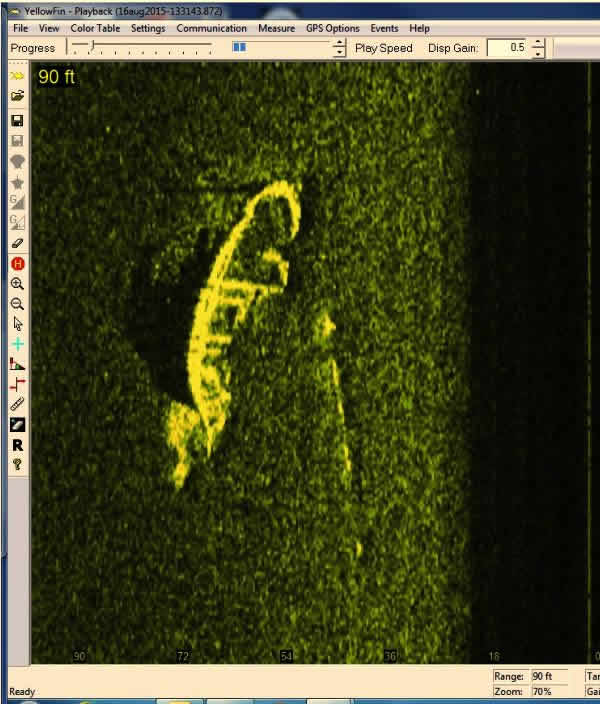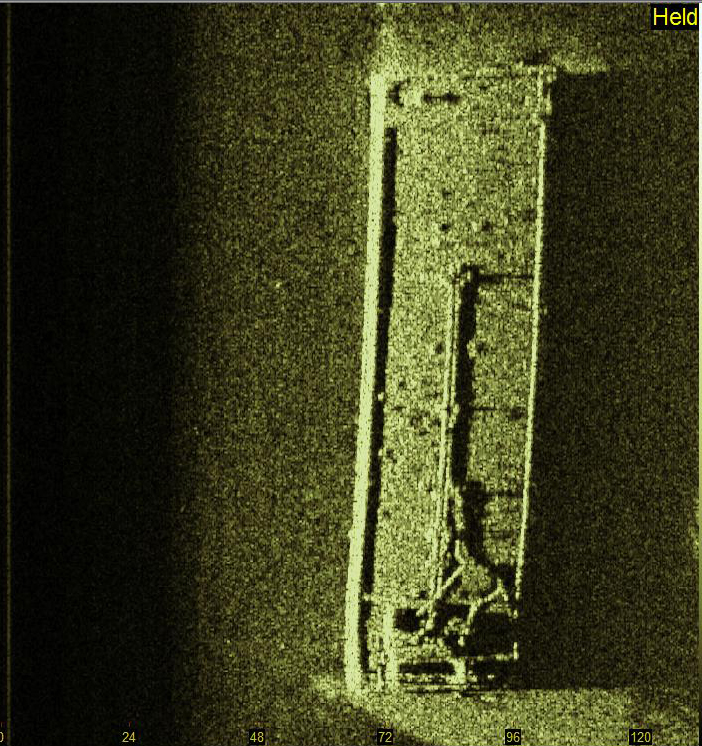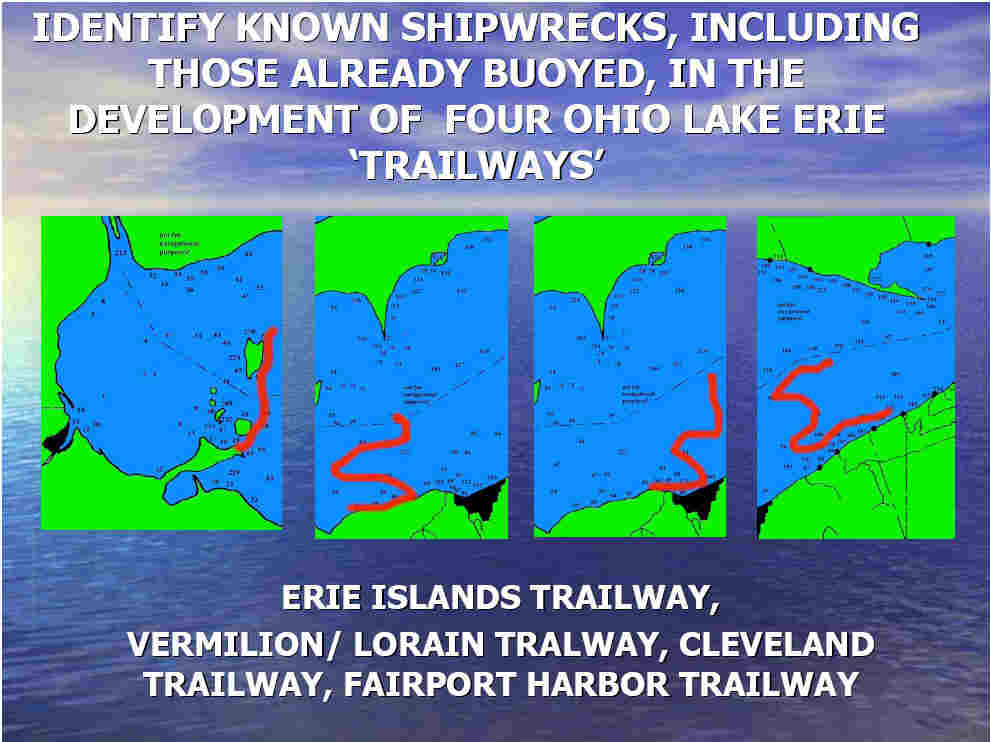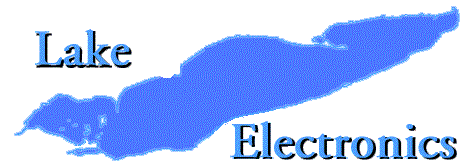|


| |
Shipwrecks tell of Lake Erie's history
Sch Lake Serpent located! Believed to be the oldest shipwreck in Lake Erie.  Survey work confirms figurehead and major dimensions consistent witht he historical records of the vessel. Multiple dives by the survey team worked to document the major features of this wreck. Overall dimensions, including the stern section, part of the transom and the rudder and rudder post were found. The bow section was uncovered to reveal a figurehead. The Starbord anchor was found as well as some stone in the center of the hull. These stone are smoothll and rounded, not quarried as limestone would have been shaped. The Sch. Lake Serpent was returning from the islands (to Cleveland) with stone in the fall of 1829 when she encountered rough weather and never arrived at that port. The bodies of the crew and passangers were found floating between Sandusky and Lorain. The location of the shipwreck was never known. Survey work confirms figurehead and major dimensions consistent witht he historical records of the vessel. Multiple dives by the survey team worked to document the major features of this wreck. Overall dimensions, including the stern section, part of the transom and the rudder and rudder post were found. The bow section was uncovered to reveal a figurehead. The Starbord anchor was found as well as some stone in the center of the hull. These stone are smoothll and rounded, not quarried as limestone would have been shaped. The Sch. Lake Serpent was returning from the islands (to Cleveland) with stone in the fall of 1829 when she encountered rough weather and never arrived at that port. The bodies of the crew and passangers were found floating between Sandusky and Lorain. The location of the shipwreck was never known.
 On Friday, August 28, 2015, while performing a historical shipwreck side scan sonar search in the waters of Lake Erie, Tom Kowalczk of Cleveland Underwater Explorers (CLUE) detected a target of interest on the otherwise featureless lake bottom east of the Lake Erie islands. Taking advantage of favorable weather and lake conditions and utilizing the capabilities of the electronics aboard his well-equipped vessel, Kowalczk was able to obtain high resolution, high quality side scan sonar images of what appeared to be a large intact barge sitting upright on the bottom of the lake. Kowalczk, whose remote sensing and navigation skills are exceeded only by his knowledge of Great Lakes history, ships and shipwrecks, was quite confident that he had found the tank barge Argo which had been abandoned in a sinking condition during an autumn gale in the early morning hours of Oct. 20, 1937. The Argo was last seen afloat in this general area and eventually sank. A subsequent search performed by the United States Coast Guard (USCG) failed to locate the wreck at the time and the exact location of the sunken barge was never determined. On Friday, August 28, 2015, while performing a historical shipwreck side scan sonar search in the waters of Lake Erie, Tom Kowalczk of Cleveland Underwater Explorers (CLUE) detected a target of interest on the otherwise featureless lake bottom east of the Lake Erie islands. Taking advantage of favorable weather and lake conditions and utilizing the capabilities of the electronics aboard his well-equipped vessel, Kowalczk was able to obtain high resolution, high quality side scan sonar images of what appeared to be a large intact barge sitting upright on the bottom of the lake. Kowalczk, whose remote sensing and navigation skills are exceeded only by his knowledge of Great Lakes history, ships and shipwrecks, was quite confident that he had found the tank barge Argo which had been abandoned in a sinking condition during an autumn gale in the early morning hours of Oct. 20, 1937. The Argo was last seen afloat in this general area and eventually sank. A subsequent search performed by the United States Coast Guard (USCG) failed to locate the wreck at the time and the exact location of the sunken barge was never determined.
By
MIKE FITZPATRICK | Sunday July 06 2008, 2:21am
VERMILION

The only known image of the steamer Anthony Wayne. Provided illustration


 About
60 feet below the surface of Lake Erie, two large paddlewheels rise upward from
the wreckage of the Anthony B. Wayne, a sidewheel steamer that sank 158 years
ago, about six miles off the coast of Vermilion. About
60 feet below the surface of Lake Erie, two large paddlewheels rise upward from
the wreckage of the Anthony B. Wayne, a sidewheel steamer that sank 158 years
ago, about six miles off the coast of Vermilion.
A team from the Peachman Lake Erie Shipwreck Research Center is exploring the
remains of the steamer to learn more about the ship and the history of the Great
Lakes.
The Peachman center is in a small, old house behind the
Inland Seas Maritime Museum on Vermilion's lakeshore. If you go inside
expecting to see a bunch of James Bond-type gadgets for locating sunken ships,
you've come to the wrong house. Instead, you'll find file cabinets, along with
some air tanks strewn across the floor.
You'll also meet Carrie Sowden, archaeological director of the center, who is
teaming with two Texas A&M graduate students to explore the wreckage of the
Anthony B. Wayne.
The Wayne sank shortly after midnight April 28, 1850, after the steamer's
boilers exploded. The ship, heading from Sandusky to Buffalo, was carrying
80-100 passengers along with a cargo of wine, whiskey and livestock. About 30
passengers survived.
"I think the shipwrecks are important because they truly tell our story,"
Sowden said. By "our story," Sowden means the history of the Great Lakes.
The Wayne wreckage was discovered by Tom Kowalczk of Lakeside. He first came
across the sunken ship in the fall of 2006 using a sidescan sonar system.
"Some of the detail in the paddlewheel showed up on the screen," Kowalczk
said.
A dive to survey the wreck in the spring of 2007 confirmed to Kowalczk he'd
found the Wayne.
"We took some preliminary measurements and surveyed and found enough
circumstantial data to call it the Anthony Wayne," he said.
Hours of research and searching take place before a wreck is discovered,
Kowalczk said.
"You kind of know where they are. You have a general area, but there is no X
marks the spot," he said.
David Kelch, an associate professor and extension specialist of The Ohio Sea
Grant Program, helped put together an interactive Web site,
www.ohioshipwrecks.org, that provides information on 28 shipwreck sites. The
site has an interactive map showing the approximate location of other
shipwrecks.
"Finding a shipwreck can be like trying to find a needle in a haystack,"
Kelch said.
Now that the Wayne has been found, Brad Krueger, who is working on his
master's degree in Texas A&M's Nautical Archeology program, hopes to learn all
he can about the steamer.
"It's one of the earliest examples of a passenger and cargo steamer that we
have, probably one of the oldest in Lake Erie," Krueger said.
Krueger, fellow Texas A&M master's candidate Will Moser and Sowden make daily
dives to the wreckage site, where they take measurements of the steamer's
remains.
The exposed paddle wheels are the most impressive part of the submerged
wreck, Krueger said.
"To see these two great structures looming on the bottom and coming into
focus ... to see them rising up is impressive," Krueger said.
Krueger, a native of Ann Arbor, Mich., said growing up around the Great Lakes
led him to pursue an advanced degree in nautical archeology. He hopes his study
of the Wayne will uncover how the steamer was constructed.
"We don't know how the ship was built. There are no blueprints or plans. They
weren't constructed by a plan," Krueger said.
Krueger would eventually like to learn more about day-to-day life on the
steamer.
"Was it a floating palace? Was it a derelict that people were afraid to get
on?" Krueger asked.
No photos of the steamer exist -- only a lithograph that was produced in
1837. The Wayne was 155 feet long, and the paddlewheels were 26 feet high.
Shipwrecks intrigue archeologists, Sowden said, because they offer a snapshot
of time.
"It's interesting to think that it had not been seen since 1850," Sowden
said.
Investigating the wreckage helps them piece together its history.
"The people that lost stuff on the boat and people who built it, and why it
was built and why it was named the Anthony Wayne," she said. "There are so many
different questions you can ask and answer, and so many different people
involved with one moment in time happening."
The Great Lakes Historical Society operates the Inland Seas museum as well as
Peachman center. One of the goals of the historical society is to document Lake
Erie shipwrecks, Sowden said.
Locating wreck sites is just one obstacle faced by divers, Kelch said. Once
they find the wreck site, a lot of times the ship remains have deteriorated.
"Some of the wrecks around the islands (have) nothing left but a scattering
of debris. And some of the wrecks out there are buried under Lord knows how many
feet of silt. There are wrecks that will never be found because they are out of
sight," Kelch said.
As an example Kelch points to The Adventure, a ship that went down in the
back bay of Kelleys Island in October 1903. The Adventure, carrying limestone,
went down when its boilers caught fire.
"That shipwreck is only in about 6-8 feet of water. A lot of people go to
that wreck because it's easily accessible and you can see it. But a lot of it
has been destroyed because of years and years of wave action," Kelch said.
July 2006 - the proposed trailways 
October, 2005 -
Map to Ohio shipwrecks in works
 Officials try to promote Lake Erie sites while avoiding
land conflicts Officials try to promote Lake Erie sites while avoiding
land conflicts
 Associated Press Associated Press
KELLEYS ISLAND
- When state officials tried to mark several Lake Erie shipwreck
sites as preserves two years ago, they tussled with property owners over land
rights.
Now the state, lake historians and underwater archaeologists are hoping to
mark four of the lake's zones as ``underwater trailways.'' The routes would
guide divers to historic shipwrecks without parceling off properties.
``The trailways idea is to promote Lake Erie, hopefully without making people
uncomfortable,'' said Constance Livchak, supervisor of the Division of Geologic
Survey with the Ohio Department of Natural Resources. ``It's not a boundary,
where there's a box. A trailway is more of a guide from one shipwreck to the
next.''
Lake Erie has at least 1,500 shipwrecks, many dating back to the late 1800s
and early 1900s, when shipping traffic there was heavier. About 600 of those
wrecks are in Ohio, said Chris Gillchrist, executive director of the Great Lakes
Historical Society.
ODNR is vying for a three-year, $220,000 grant from the National Oceanic and
Atmospheric Administration to start the mapping plan. If the grant goes through,
the state will add $63,000 to the project's budget.
The leader on the project is Dave Kelch, an associate professor and district
specialist with Ohio State University's Sea Grant Extension program.
He said he hopes to publish a 16- to 20-page guide to shipwrecks in four Lake
Erie zones. The brochure will include photographs, historical details and
coordinates that will allow divers to locate the sites with global positioning
equipment.
He also wants to set up a Web site with virtual dives for surfers who don't
want to get their feet wet.
The plan is based on a Wisconsin program that maps out dozens of shipwrecks
in Lakes Michigan and Superior.
``There's a lot of support and a lot of interest in the maritime history of
the Great Lakes,'' said Keith Meverden, a Wisconsin underwater archaeologist.
The expense of documenting each shipwreck's location and remains is high,
said Gillchrist, so putting together an exhaustive database would be nearly
impossible.
``What we're striving for is a representation of the diversity of boats,'' he
said, ``so that as people go through these trails, they understand that
passenger boats and other work boats were subject to the same forces of
nature.''
The Division of Geologic Survey is using sonar equipment to learn more about
Ohio's wreck sites, Livchak said during an exploration of a 1911 shipwreck off
Kelleys Island.
February, 2005 Submerged Lands Advisory Council - During the previous session of the Ohio General
Assembly, a bill was passed that sunsetted a number of government advisory
boards. Among those was the Submerged Land Advisory Council for the Ohio Coastal
Management Program. As of January 1, 2005, the Submerged Lands Advisory Council
no longer exists. To ensure the functions of the former council are not lost, in
November 2004 the Coastal Resources Advisory Council unanimously voted to create
the Submerged Historical and Geological Resources committee. The committee,
similar to the former Council will focus on shipwrecks and other underwater
historic preservation efforts
January, 2005 - In 2005 MAST will
for the first time have grant money from ODNR Coastal management to moor 6
wrecks in Ohio waters. The wrecks moored will be the steamers Sand Merchant,
Queen of the West, Morning Star and Sarah Sheldon,
the tug Admiral and the schooner
barge Dundee.
August 19, 2004 - excerpts from the meeting minutes of the
Ohio Coastal Resources Advisory Council at Stone Laboratory, Gibraltar Island,
Put-in-Bay
Taskforce Reports
Application Review Taskforce
– Mr. Hayes said there was no report.
Legislation – The legislation is currently inactive.
Underwater Preservation – Mr. Hayes said there is a desire to
protect the underwater historical, geological and botanical sites and some
people fear that a major marina will be built over a popular shipwreck just off
the north shore of Kelleys Island. Mr. Mackey said the issue of historical
underwater preservation is also being discussed by the Submerged Lands Advisory
Council. Mr. Goudreau said he is a member of the Great Lakes Historical Society
and they have a strong desire to work with the Office of Coastal Management and
their advisory councils.
April 27, 2004 - excerpts from the minutes of the Submerged
Lands Advisory Council meeting.
III. Underwater Preserves
Dave Mackey reported that there was no change in the status of
any attempt to establish an underwater preserve in Lake Erie. After Kelleys
Island withdrew support for a Kelleys Island Preserve, three public meetings
were held to solicit public opinion about a proposed alternate site for a
preserve in the Western Basin. At the meetings, which took place at Kelleys
Island, Put-in-Bay and in Port Clinton, a number of knowledgeable people had
negative comments. Divers and charter captains stated that the proposed site had
muddy bottoms, low visibility and few if any wrecks; political subdivisions
didn’t want such preserves. The general impression was that people just don’t
want a box in the lake. Therefore, ODNR has taken no further action to pursue an
underwater preserve. The council discussed the value of informational pamphlets
and buoys in the absence of underwater preserves. Dave Mackey stated that the
Shipwreck Center should be able to support a project to produce pamphlets
providing information on shipwrecks.
August 7, 2003 - Comments by
former mayor William “Bill" Minshall, 519 Titur Road, Kelleys Island, Ohio at
the Coastal Resources Advisory
Council Meeting,
Ohio Revised Code section
1506.31 rules establishing Lake Erie submerged lands preserves: access, gives
two unelected officials, the Director of Natural Resources and the Director of
the Ohio Historical Society, complete control of the preserve and all the waters
within it by the adoption of rules under chapter 119 of the Revised Code. The
preserve area extends from the lake bed to the surface. An area may be set aside
today as a preserve for shipwrecks, however, tomorrow comes with new directors
and new rules.
O.R.C. 1506.31 provides that in
addition to shipwrecks, “Other features of archaeological, historical,
recreational, ecological, environmental, educational, scenic, scientific, or
geological value,” may be given preserve status. Today’s shipwreck preserve,
with the help of one or two scientific studies, will become tomorrow’s
environmentally scientific area off limits to almost all but scientific
researchers. Florida, California and Hawaii have experienced this exact
circumstance. To say it will not happen here is foolhardy....... end of Mr.
Minshall's comments.
Mr.
Mackey said OCM (Ohio Coastal
Management)
wants to follow up with additional investigations with some of the people who
are knowledgeable regarding these issues particularly the dive groups,
archeologists and others. Mr. Mackey said the term preserve might be one of the
problems that exist with the name “underwater preserve” because some folks think
there will be restrictions................
Mr.
Mackey said the ODNR has made it clear that there will be no restrictions
on activities in the preserve that are currently allowed by Ohio law............
Mr.
Mackey said of the comments against a preserve, most said they had concerns
about possible future restrictions..............
Mr.
Hayes said Ohio is the only Great Lakes state without an underwater preserve and
in Michigan, small communities are begging for the preserve because of the
benefit to ecotourism. Mr. Hayes said it is not likely that the Division of
Wildlife would ever propose taking fishing in Lake Erie’s western basin away.
April, 2003 - New boundaries established for the proposed Lake
Erie Islands Underwater Preserve raised some concerns at recent meetings. The
proposed area includes parts of the lake north of Kelleys Island to the Canadian
border, and west from the Kelleys Island shoal to the east side of South Bass
Island. The preserve is meant to foster archaeological and historical research
and educate the public about Ohio's maritime history.
May, 2001 - New underwater preserve containing 39 sunken ships is proposed
for the Kelleys Island area in western Lake Erie.
Ohio Department of Natural Resources officials are considering
the state's first underwater shipwreck preserve in the waters surrounding
Kelleys Island. An Ohio law passed in 1991 allows for 10 percent of the 3,277
square miles of Lake Erie submerged lands owned by the state to be turned into
preserves.

 In related activities, MAST (Ohio's Maritime Archeology Survey
Team) headed by Prof. Charles Herdendorf will begin their third underwater
archeological mapping project on the Str. F.H. Prince, located within the
proposed preserve. MAST has completed the site surveys of two other ships, the
Str. Adventure and another site located adjacent to the Adventure determined
to be a second shipwreck during the mapping process. The wreck is believed to
the W.R. Hanna. MAST's mapping of the Prince is being done in
conjunction with Ohio Archeology Week, June 17-23, 2001. In related activities, MAST (Ohio's Maritime Archeology Survey
Team) headed by Prof. Charles Herdendorf will begin their third underwater
archeological mapping project on the Str. F.H. Prince, located within the
proposed preserve. MAST has completed the site surveys of two other ships, the
Str. Adventure and another site located adjacent to the Adventure determined
to be a second shipwreck during the mapping process. The wreck is believed to
the W.R. Hanna. MAST's mapping of the Prince is being done in
conjunction with Ohio Archeology Week, June 17-23, 2001.
|
![]()

 On Friday, August 28, 2015, while performing a historical shipwreck side scan sonar search in the waters of Lake Erie, Tom Kowalczk of Cleveland Underwater Explorers (CLUE) detected a target of interest on the otherwise featureless lake bottom east of the Lake Erie islands. Taking advantage of favorable weather and lake conditions and utilizing the capabilities of the electronics aboard his well-equipped vessel, Kowalczk was able to obtain high resolution, high quality side scan sonar images of what appeared to be a large intact barge sitting upright on the bottom of the lake. Kowalczk, whose remote sensing and navigation skills are exceeded only by his knowledge of Great Lakes history, ships and shipwrecks, was quite confident that he had found the tank barge Argo which had been abandoned in a sinking condition during an autumn gale in the early morning hours of Oct. 20, 1937. The Argo was last seen afloat in this general area and eventually sank. A subsequent search performed by the United States Coast Guard (USCG) failed to locate the wreck at the time and the exact location of the sunken barge was never determined.
On Friday, August 28, 2015, while performing a historical shipwreck side scan sonar search in the waters of Lake Erie, Tom Kowalczk of Cleveland Underwater Explorers (CLUE) detected a target of interest on the otherwise featureless lake bottom east of the Lake Erie islands. Taking advantage of favorable weather and lake conditions and utilizing the capabilities of the electronics aboard his well-equipped vessel, Kowalczk was able to obtain high resolution, high quality side scan sonar images of what appeared to be a large intact barge sitting upright on the bottom of the lake. Kowalczk, whose remote sensing and navigation skills are exceeded only by his knowledge of Great Lakes history, ships and shipwrecks, was quite confident that he had found the tank barge Argo which had been abandoned in a sinking condition during an autumn gale in the early morning hours of Oct. 20, 1937. The Argo was last seen afloat in this general area and eventually sank. A subsequent search performed by the United States Coast Guard (USCG) failed to locate the wreck at the time and the exact location of the sunken barge was never determined.




 In related activities, MAST (Ohio's Maritime Archeology Survey
Team) headed by Prof. Charles Herdendorf will begin their third underwater
archeological mapping project on the Str. F.H. Prince, located within the
proposed preserve. MAST has completed the site surveys of two other ships, the
Str. Adventure and another site located adjacent to the Adventure determined
to be a second shipwreck during the mapping process. The wreck is believed to
the W.R. Hanna. MAST's mapping of the Prince is being done in
conjunction with Ohio Archeology Week, June 17-23, 2001.
In related activities, MAST (Ohio's Maritime Archeology Survey
Team) headed by Prof. Charles Herdendorf will begin their third underwater
archeological mapping project on the Str. F.H. Prince, located within the
proposed preserve. MAST has completed the site surveys of two other ships, the
Str. Adventure and another site located adjacent to the Adventure determined
to be a second shipwreck during the mapping process. The wreck is believed to
the W.R. Hanna. MAST's mapping of the Prince is being done in
conjunction with Ohio Archeology Week, June 17-23, 2001.